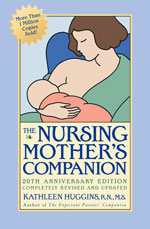Colostrum

[Adapted from The Nursing Mother's Companion, by Kathleen Huggins. Copyright © 2005, used by permission of The Harvard Common Press.]
Off To A Good Start: The First Week
You might expect that after the work of labor and birth a mother and her newborn infant would be too exhausted to greet each other. But no matter how fatigued birth may have left her, the mother usually brightens with renewed energy to explore her baby. Some mothers seem to meet their infants for the first time with puzzlement, as if searching for some sign of familiarity. Others react as if they have always known this tiny being and are overjoyed to meet him at long last.
After several minutes of adjustment to breathing, the temperature change, and lights and sounds, the infant likewise becomes alert, opening his eyes and moving his mouth. Soon he is actively rooting about. With his fists to his mouth, or perhaps his lips against the blanket or his father's arm, he seeks out the comfort of the breast.
In The Beginning
Throughout the first two hours after birth, the infant is usually alert and eager to suck. At this time he is most ready for his first nursing.
It is not unusual to hear a first-time mother tell a nurse, "I don't think I have anything yet to feed the baby." Although small in amount, colostrums is available in the breast in quantities close to the stomach capacity of the newborn. This "liquid gold," which is often yellow, but may be clear, resembles blood more than milk in that it contains protective white blood cells capable of attacking harmful bacteria. Colostrum also acts to "seal" the inside of the baby's intestines, preventing the invasion of bacteria, and provides the baby with high levels of antibodies from the mother. Not only does colostrums thus offer protection from sickness, but it is the ideal food for the newborn's first few days of life. It is high in protein and low in sugar and fat, making it easy to digest. Colostrum is also beneficial in stimulating the baby's early bowel movements. The black, tarry stool, called meconium, contains bilirubin, the substance that causes newborn jaundice. Colostrum in frequent doses helps eliminate bilirubin from the body and may lessen the incidence and severity of jaundice.
In the hospital this first nursing may take place in the delivery room, the birthing room, or the recovery area. With minimal assistance from your nurse or partner, the baby will probably latch on eagerly to the breast and suck. He will be more willing if he is unbundled; snuggled within your arm and next to your body, he is unlikely to get too cold (unless perhaps the room is air-conditioned). The purple color of his hands and feet is normal; it is caused by changes in blood circulation that take place at delivery. If you or the nurse is concerned about the cold, place a blanket over the baby after he has begun to nurse.
Many specialists believe that when the first nursing is delayed much beyond the first two hours, the infant may be somewhat reluctant to take the breast thereafter. Most babies fall asleep about two hours after birth, and become more difficult to rouse over the next few hours. Nursing without delay also boosts the confidence of the mother, and stimulates the action of hormones that cause the uterus to contract and remain firm after delivery. These contractions may help speed delivery of the placenta and minimize blood loss afterward (breastfeeding alone is insufficient, however, in the case of postpartum hemorrhage, when prompt intervention by the medical staff is essential). During the first few days after birth, some mothers feel these contractions, or "afterpains," while nursing. Mothers who have had other children may be especially uncomfortable with afterpains.
Should you not have the opportunity to nurse right after delivery, or if you can't persuade your baby to take the breast, don't get discouraged. Many mothers have established successful nursing hours or days after giving birth.
 PREGNANCY
PREGNANCY  GIVING BIRTH
GIVING BIRTH  BABY CARE
BABY CARE  HEALTH & SAFETY
HEALTH & SAFETY  FUN STUFF
FUN STUFF  FAMILY
FAMILY 